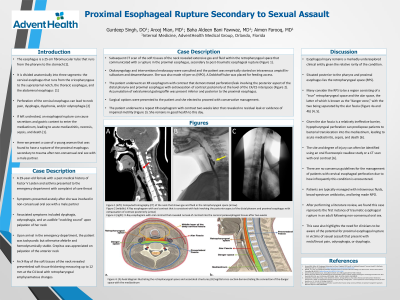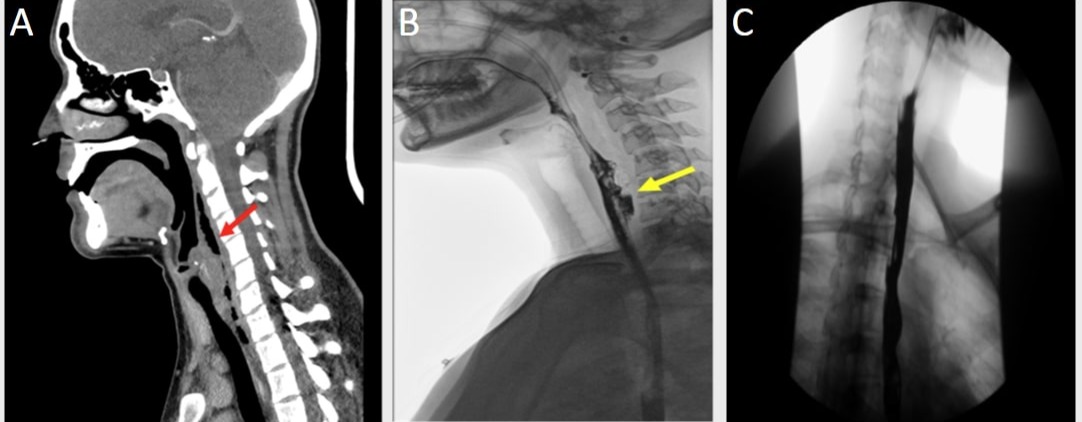Monday Poster Session
Category: Esophagus
P1923 - Proximal Esophageal Rupture Secondary to Sexual Assault
Monday, October 23, 2023
10:30 AM - 4:15 PM PT
Location: Exhibit Hall

Has Audio
- GS
Gurdeep Singh, DO
AdventHealth
Orlando, FL
Presenting Author(s)
Award: Presidential Poster Award
Gurdeep Singh, DO1, Arooj Mian, MD1, Baha Fawwaz, MD1, Naveena Chittineedi, BS2, Sahil Shah, DO3, Aimen Farooq, MD1
1AdventHealth, Orlando, FL; 2New York Medical College, Valhalla, NY; 3Campbell University School of Osteopathic Medicine, Stony Brook, NY
Introduction: Despite modern medical advances, esophageal perforation remains a challenging clinical entity for physicians. Acute perforation of the esophagus carries a high morbidity and mortality and often presents with non-specific symptoms that lead to delays in diagnosis. Here we present a case of a young woman that was found to have a rupture of the proximal esophagus secondary to trauma after non-consensual oral sex with a male partner.
Case Description/Methods:
A 29-year-old female with a past medical history of Factor V Leiden and asthma presented to the emergency department with complaint of sore throat after she was involved in non-consensual oral sex with a male partner. Shortly thereafter, she heard an audible pop and began to experience sudden pain in her throat, dysphagia, odynophagia, and an audible “crackling sound” upon palpation of her neck. She subsequently elected to seek medical attention.
Upon arrival in the emergency department, the patient was tachycardic but otherwise afebrile and hemodynamically stable. Crepitus was appreciated on palpation of the anterior neck. CT scan of the soft tissues of the neck revealed extensive gas and fluid within the retropharyngeal space that communicated with a rupture in the proximal esophagus, likely secondary to post-traumatic esophageal rupture. The patient was subsequently admitted to the hospital and was empirically started on intravenous ampicillin-sulbactam and dexamethasone.
Otolaryngology and interventional endoscopy were consulted and recommended that the patient be made NPO. A Dobbhoff tube was placed for feeding access. The patient underwent an XR esophagram with contrast that demonstrated perforation/leak involving the posterior aspect of the proximal esophagus with extravasation of contrast posteriorly. Treatment options were presented to the patient, and she elected to proceed with conservative management. She was subsequently discharged with a Dobbhoff tube. The patient underwent a repeat XR esophagram with contrast two weeks later that revealed no residual leak or impaired motility. She was started on an oral diet and remains in good health to this day.
Discussion: After an extensive literature review, we found this case represents the first instance of traumatic esophageal rupture in an adult following non-consensual oral sex. This case also highlights the need for clinicians to be aware of the potential for proximal esophageal rupture in victims of sexual assault that present with throat pain, odynophagia, or dysphagia afterwards.

Disclosures:
Gurdeep Singh, DO1, Arooj Mian, MD1, Baha Fawwaz, MD1, Naveena Chittineedi, BS2, Sahil Shah, DO3, Aimen Farooq, MD1. P1923 - Proximal Esophageal Rupture Secondary to Sexual Assault, ACG 2023 Annual Scientific Meeting Abstracts. Vancouver, BC, Canada: American College of Gastroenterology.
Gurdeep Singh, DO1, Arooj Mian, MD1, Baha Fawwaz, MD1, Naveena Chittineedi, BS2, Sahil Shah, DO3, Aimen Farooq, MD1
1AdventHealth, Orlando, FL; 2New York Medical College, Valhalla, NY; 3Campbell University School of Osteopathic Medicine, Stony Brook, NY
Introduction: Despite modern medical advances, esophageal perforation remains a challenging clinical entity for physicians. Acute perforation of the esophagus carries a high morbidity and mortality and often presents with non-specific symptoms that lead to delays in diagnosis. Here we present a case of a young woman that was found to have a rupture of the proximal esophagus secondary to trauma after non-consensual oral sex with a male partner.
Case Description/Methods:
A 29-year-old female with a past medical history of Factor V Leiden and asthma presented to the emergency department with complaint of sore throat after she was involved in non-consensual oral sex with a male partner. Shortly thereafter, she heard an audible pop and began to experience sudden pain in her throat, dysphagia, odynophagia, and an audible “crackling sound” upon palpation of her neck. She subsequently elected to seek medical attention.
Upon arrival in the emergency department, the patient was tachycardic but otherwise afebrile and hemodynamically stable. Crepitus was appreciated on palpation of the anterior neck. CT scan of the soft tissues of the neck revealed extensive gas and fluid within the retropharyngeal space that communicated with a rupture in the proximal esophagus, likely secondary to post-traumatic esophageal rupture. The patient was subsequently admitted to the hospital and was empirically started on intravenous ampicillin-sulbactam and dexamethasone.
Otolaryngology and interventional endoscopy were consulted and recommended that the patient be made NPO. A Dobbhoff tube was placed for feeding access. The patient underwent an XR esophagram with contrast that demonstrated perforation/leak involving the posterior aspect of the proximal esophagus with extravasation of contrast posteriorly. Treatment options were presented to the patient, and she elected to proceed with conservative management. She was subsequently discharged with a Dobbhoff tube. The patient underwent a repeat XR esophagram with contrast two weeks later that revealed no residual leak or impaired motility. She was started on an oral diet and remains in good health to this day.
Discussion: After an extensive literature review, we found this case represents the first instance of traumatic esophageal rupture in an adult following non-consensual oral sex. This case also highlights the need for clinicians to be aware of the potential for proximal esophageal rupture in victims of sexual assault that present with throat pain, odynophagia, or dysphagia afterwards.

Figure: A: Computed tomography (CT) of the neck that shows gas and fluid in the retropharyngeal space (arrow).
B: X-Ray esophagram with oral contrast that is consistent with leak involving the posterior aspect of the distal pharynx and proximal esophagus with extravasation of contrast posteriorly (arrow).
C: X-Ray esophagram with oral contrast that revealed no leak of contrast into the cervical paraesophageal tissues after two weeks.
B: X-Ray esophagram with oral contrast that is consistent with leak involving the posterior aspect of the distal pharynx and proximal esophagus with extravasation of contrast posteriorly (arrow).
C: X-Ray esophagram with oral contrast that revealed no leak of contrast into the cervical paraesophageal tissues after two weeks.
Disclosures:
Gurdeep Singh indicated no relevant financial relationships.
Arooj Mian indicated no relevant financial relationships.
Baha Fawwaz indicated no relevant financial relationships.
Naveena Chittineedi indicated no relevant financial relationships.
Sahil Shah indicated no relevant financial relationships.
Aimen Farooq indicated no relevant financial relationships.
Gurdeep Singh, DO1, Arooj Mian, MD1, Baha Fawwaz, MD1, Naveena Chittineedi, BS2, Sahil Shah, DO3, Aimen Farooq, MD1. P1923 - Proximal Esophageal Rupture Secondary to Sexual Assault, ACG 2023 Annual Scientific Meeting Abstracts. Vancouver, BC, Canada: American College of Gastroenterology.

